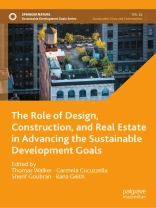This edited book brings together insights from scholars and practitioners from many different fields to uncover the role of the construction and real estate sectors and how they align with the Sustainable Development Goals (SDGs). It follows a lifecycle-based approach to the topic, addressing the design, construction, management, investment, and regulatory dimensions of projects in the area. It expands the reader’s understanding of the built environment beyond the design and construction phases, which enables the collection to explore the links and transitions between different project phases and uncover new methodologies that aim to tackle systemic sustainable development challenges. The chapters’ comprehensive coverage allows the collection to capitalize on the strengths and weaknesses of the building industry, highlight emerging trends, and uncover some critical gaps that need to be addressed to attain the 2030 vision. This puts into perspective the interconnected nature of the SDGs and highlights the importance of multi-stakeholder collaborations in achieving them.
สารบัญ
1. Towards Realizing the 2030 Agenda in the Built Environment: An Introduction.- SECTION I: DESIGNING MORE SUSTAINABLE HUMAN SETTLEMENTS.- 2. The Potential of New Methodologies, Approaches, and Artificial Intelligence Techniques in Addressing the Urgent Development Challenges of the Built Environment.- 3. Achieving the Agenda 2030 in the Built Environment: Role, Benefits, and Challenges in Implementing Green Infrastructure in Informal Settlements.- 4. Determining an Adequate Population Density to Achieve Sustainable Development and Quality of Life.- 5. Solar Shading Design and Implementation in UK Housing as a Tool for Advancing Sustainable Development.- SECTION II: BUILT ENVIRONMENT POLICY AND GOVERNANCE INNOVATIONS.- 6. Habitat Hippodrome: Housing Decommodification towards Sustainable Development.- 7. How Rwanda’s Green Building Minimum Compliance System Can Help Achieve the Sustainable Development Goals.- 8. Achieving the Sustainable Development Goals Through the Integration of Social Procurement in Construction Projects.- SECTION III: SYSTEMIC APPROACHES TO BUILT ENVIRONMENT SYSTEMS.- 9. Changes in Building Culture and their Effect on Carbon Footprints: The Past to Present of Şanlıurfa-Turkey.- 10. Partnership in the Built Environment for Realizing the 2030 Agenda: A Soft Systems Model Incorporating Systems Theory and Circular Economy.- 11. A Sustainable Approach to Planning, Organization, and Management of Big Events Related to the Music Entertainment Industry.- 12. Equity in the Built Environment in the Least Developed Countries: The Case of Rural Municipalities in Nepal.
เกี่ยวกับผู้แต่ง
Thomas Walker is Professor of Finance at Concordia University. He has published over seventy journal articles and books in the area of finance and sustainable real estate. He currently serves as Director of the BMO Centre for Capital Markets and holds a research chair in emerging risk management.
Carmela Cucuzzella is Professor in the Design and Computation Arts Department at Concordia University. She is the founding co-director of the Next Generation Cities Institute (NGCI), where she is responsible for research in the areas of design, arts, architecture, community, and culture for the future city. She holds the University Research Chair in Integrated Design And Sustainability for the Built Environment (IDEAS-BE).
Sherif Goubran is Assistant Professor of sustainable design at the Department of Architecture at the American University in Cairo (AUC). His research focuses on sustainability assessment and application in the built environment and on integrating sustainable development principles in buildings. His work intersects the fields of design, architecture, building engineering, and real estate finance.
Rana Geith is a landscape architect at Dar Al-Handasah (DAR), Cairo and a research assistant in the Department of Architecture at the American University in Cairo (AUC), where she graduated with a Bachelor of Science in Architectural Engineering. Her research endeavors aim to uncover links between architecture and sustainable development in the built environment.












